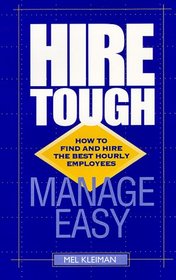Search -
Hire Tough, Manage Easy : How to Find and Hire the Best Hourly Employees
Hire Tough Manage Easy How to Find and Hire the Best Hourly Employees
Author:
According to statistics from the U.S. Department of Labor, businesses spent an estimated $26 billion in 1996 alone on hiring hourly employees. The Department also reports that half those employees were gone within six months - an incredible turnover rate of 100 percent per year. Mel Kleiman, a nationally recognized authority on recruiting, sele... more »
Author:
According to statistics from the U.S. Department of Labor, businesses spent an estimated $26 billion in 1996 alone on hiring hourly employees. The Department also reports that half those employees were gone within six months - an incredible turnover rate of 100 percent per year. Mel Kleiman, a nationally recognized authority on recruiting, sele... more »
ISBN-13: 9781893214002
ISBN-10: 1893214001
Publication Date: 1/25/1999
Pages: 184
Rating: ?
ISBN-10: 1893214001
Publication Date: 1/25/1999
Pages: 184
Rating: ?
0 stars, based on 0 rating
Genres:
- Business & Money >> Job Hunting & Careers >> Job Hunting >> Interviewing
- Business & Money >> General
- Business & Money >> Industries >> Human Resources & Personnel Management





